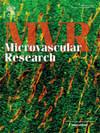KATP 通道抑制诱导的骨骼肌低血流量:没有证据表明毛细血管前括约肌起作用。
IF 2.9
4区 医学
Q2 PERIPHERAL VASCULAR DISEASE
引用次数: 0
摘要
本文章由计算机程序翻译,如有差异,请以英文原文为准。
KATP channel inhibition-induced hyporemia in skeletal muscle: No evidence for pre-capillary sphincter action
Introduction
Whether pre-capillary sphincters are present and regulate red blood cell (RBC) flux at the individual capillary level, especially in skeletal muscle, is controversial. Recently, blockade of KATP channels using the sulphonylurea glibenclamide (GLI) was demonstrated to reduce muscle blood flow and lower vascular conductance. The present investigation tested the hypothesis that, if pre-capillary sphincters were involved in GLI-induced blood flow reductions, a defined luminal narrowing would be evident in the proximate region of the capillaries.
Methods
Videomicroscopy of the spinotrapezius capillary bed was performed under control (Krebs-Henseleit) and GLI (200 μM in Krebs-Henseleit) superfusion. Capillary RBC flux was measured within individual capillaries and their luminal diameter was measured using a calibrated digital ruler at the branch-point and subsequently downstream.
Results
GLI reduced capillary RBC flux by 31% (p = 0.004). Despite the presence of a reduced RBC flux, no detectable reduction or, indeed, any change in capillary luminal diameter was present at any measurement site. The average diameter at the branching point was 4.9 ± 0.3 μm, and at 5, 10, 20 and 50 μm downstream, the average diameters were 4.8 ± 0.4, 4.8 ± 0.5, 5.0 ± 0.7, and 5.2 ± 0.4 μm, respectively and were unchanged by GLI (all P > 0.05).
Conclusions
Accordingly, the absence of any evidence for capillary luminal narrowing or constriction in these data support that the GLI-induced reductions in capillary RBC flux and muscle blood flow occur via upstream effects within the arteriolar bed. Decreases in skeletal muscle microcirculatory RBC flux with this KATP channel blocker were not regulated by any detectable capillary structural alterations.
求助全文
通过发布文献求助,成功后即可免费获取论文全文。
去求助
来源期刊

Microvascular research
医学-外周血管病
CiteScore
6.00
自引率
3.20%
发文量
158
审稿时长
43 days
期刊介绍:
Microvascular Research is dedicated to the dissemination of fundamental information related to the microvascular field. Full-length articles presenting the results of original research and brief communications are featured.
Research Areas include:
• Angiogenesis
• Biochemistry
• Bioengineering
• Biomathematics
• Biophysics
• Cancer
• Circulatory homeostasis
• Comparative physiology
• Drug delivery
• Neuropharmacology
• Microvascular pathology
• Rheology
• Tissue Engineering.
 求助内容:
求助内容: 应助结果提醒方式:
应助结果提醒方式:


